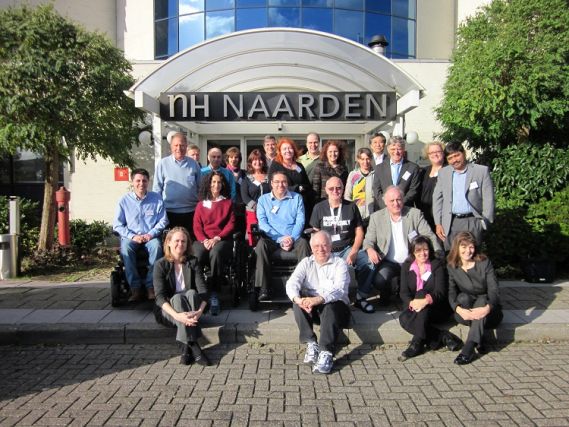Clinical Characteristics, Pathomechanisms and Trial Design for Calpainopathy (LGMD2A)
- Number 202
- Date 21 November 2013
Location: Naarden
This workshop was co-sponsored by Coalition to Cure Calpain 3, The Clifton R. Lewis Good Life Foundation and Beyond Labels&Limitations.
Background
The limb girdle muscular dystrophies (LGMDs) are comprised of 18 different genetically inherited diseases that present with progressive proximal skeletal muscle wasting. LGMD type 2A is due to mutations in CAPN3, and is considered one of the most prevalent LGMD. CAPN3 encodes for the proteolytic enzyme calpain 3, which is the muscle specific member of a large protease family with pleiotropic functions. It is not yet clear why mutations in calpain 3 lead to muscle disease.
Rationale for the Workshop
LGMD2A patients have a clinically distinct phenotype from other LGMDs. A prominent phenotypic feature is severe involvement of the posterior thigh muscle and adductors, with abductor sparing. The disease is strongly associated with muscle atrophy without rampant muscle degeneration, no cardiac involvement and mildly elevated CK. Membrane damage and muscle degeneration are not prominent features. Because of the unique clinical presentation of these patients, identification of LGMD2A-specific therapies will require development of LGMD2A-specific clinical trial outcome measures. Furthermore, there is a need for more basic science studies aimed at understanding pathomechanisms of disease to identify therapeutic targets. As therapeutic targets are identified, there is increased need to consider the steps that will be necessary to move the field forward to trials. A workshop specific to LGMD2A allows for concentrated discussion specific to the unique features of LGMD2A.
Objective of the meeting
The objective of this meeting was to gather various neuromuscular experts and scientists together to discuss basic science data and clinical information pertaining to calpainopathy to achieve two primary goals: (1) to facilitate data exchange and communication on the state of the calpainopathy field among scientists working in different countries around the world and (2) to bring these experts together to determine the steps necessary to move the field toward clinical trials in calpainopathy; specifically, to determine whether the current clinical knowledge about the phenotypic features of calpainopathy is sufficient to develop a protocol for muscle testing.
Conclusions of the meeting
The meeting was co-organized between ENMC and the Coalition to Cure Calpain 3, a non profit organization from the US. Twenty three participants from 10 different countries, spanning 4 different continents met and exchanged information pertaining to LGMD2A research, clinical phenotyping, outcome measures and drug development. Specific outcomes that were achieved during the meeting were as follows:
- There is a strong need to better understand mechanisms of disease. To achieve this goal, the calpain 3 knock out mouse needs to be crossed to a more severe background and patient material needs to be more available for study. Also, there is a need for new models, such as the zebrafish model, that can be used to identify drugs in high throughput screens.
- There is a need to better understand natural history of LGMD2A and to develop LGMD2A-specific outcome measures. Since this is a slowly progressing disease, natural history studies will need to be carried out over at least a 3-year time span.
- There is a strong need to develop outcome measures for non-ambulant patients.
- The current LGMD2A patient registry should be expanded to capture patients in Europe and elsewhere around the world. To involve non-English speaking countries, the Coalition to Cure Calpain 3 website should be translated to other languages.
- Those interested in developing therapies need to consider the regulatory and IP aspects very early in the process.
- Efforts should be made to increase patient involvement in data collection. One way to do this is through self-reporting through iphone apps, which could be used to track daily activity and some aspects of disease progression.

